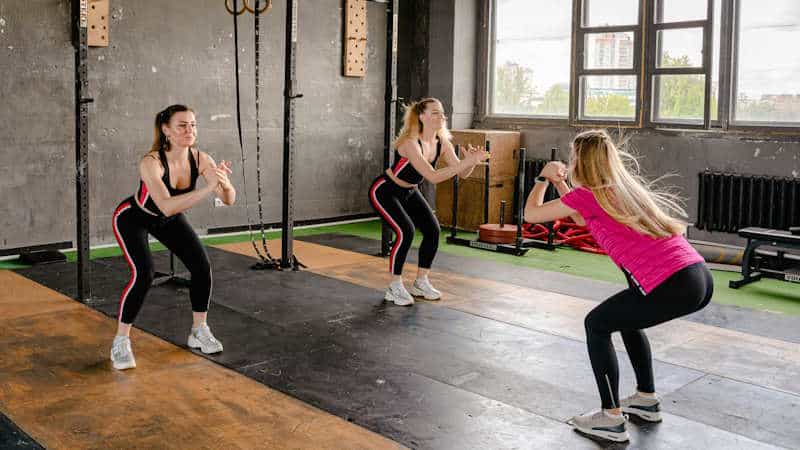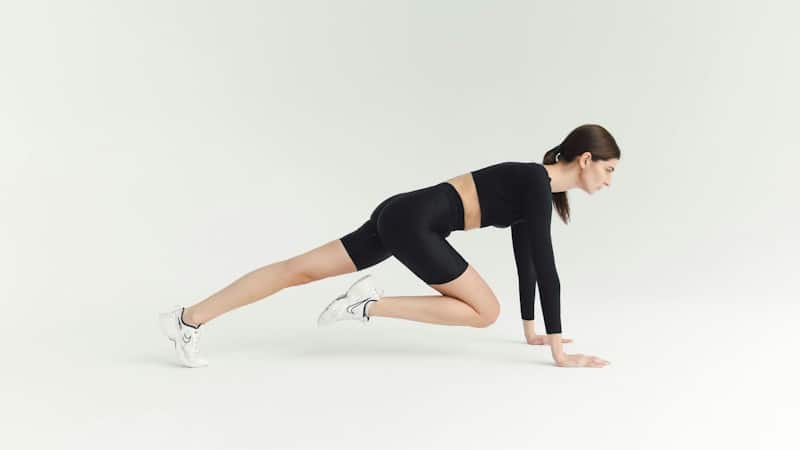HIIT isn’t some trendy acronym thrown around by fitness fanatics—it’s the answer to those mornings when your bed feels like the comfiest prison on earth. You know the drill. It’s 5 A.M., your alarm sounds like an angry robot, and your blanket has wrapped itself around you like it’s begging you to stay.
The idea of a long, slow workout? Laughable. But HIIT? That’s different.
It whispers, “Give me 20 minutes and I’ll do more for you than an hour on the treadmill.”
It’s quick, brutal, and weirdly addictive. You sweat hard, breathe fire, and somehow feel alive before your coffee even brews.
For anyone juggling life’s chaos, HIIT turns morning madness into a win before sunrise.
1. What Is HIIT?

High-Intensity Interval Training—HIIT for short—isn’t just a flashy acronym to make workouts sound cooler. It’s a simple, punchy approach to getting fit that flips the traditional gym routine on its head. Instead of grinding through an hour of steady effort, you go hard for a short burst, then catch your breath. Rinse and repeat. The result? Maximum results in minimum time.
Picture this: you sprint for 30 seconds like you’re chasing a runaway shopping cart, then walk it off for 60. Then do it again. And again. You’re pushing your limits in short windows, letting your heart race and your muscles scream, then letting them cool just enough to go again.
You can HIIT with anything—sprinting, cycling, jump squats, burpees, or just your own bodyweight. It’s not about fancy gear. It’s about effort. Intensity is the engine. The intervals are the rhythm. And the results? Surprisingly real.
Why All the Hype?
Because HIIT feels like cheating—but in a good way. You get big results in a small window of time. We’re talking torching calories, boosting your metabolism, and building stamina—all in a session that’s shorter than your favorite Netflix episode. That’s the magic.
But the real kicker? Your body keeps burning calories after you’re done. It’s called the afterburn effect (or EPOC, if you like sounding fancy). Your muscles need more oxygen to recover, so your system keeps working—while you’re chilling on the couch.
Plus, there’s a mental thrill in the structure. Short bursts of effort feel manageable. You’re not stuck in a never-ending jog. You’re doing battle in rounds. That structure creates urgency, intensity, and a strange sense of fun. You suffer a little, sweat a lot, and finish feeling like a warrior with a stopwatch.
The Real-Life Benefits
HIIT isn’t just another workout—it’s a lifestyle cheat code. You show up, sweat like you’re being chased, and walk away with serious perks. No fluff, just fast results that hit where it matters.
Here’s why people swear by it:
- Time-saver: A solid HIIT session can fit into your lunch break. Ten to twenty minutes and you’re done. No more “I don’t have time” excuses.
- Fat-burning furnace: Your metabolism shifts into overdrive. Thanks to the afterburn effect, your body keeps burning calories even when you’re watching cat videos later.
- Heart health boost: Those intense intervals challenge your cardiovascular system, making your heart tougher and more efficient.
- No gym needed: Your living room, backyard, or hallway works fine. HIIT is location-independent.
- Mental grit: Pushing through those last seconds trains more than just muscles. It sharpens your mind, too.
It’s sweaty, gritty, and oddly addictive. Just how progress should feel.
It’s like espresso for your fitness routine—small but powerful.
What Does a Typical HIIT Workout Look Like?

Imagine a workout that feels more like a high-speed chase than a gym routine. That’s HIIT. You go full throttle for a short burst, then ease off just long enough to breathe again. No long slogs. Just fire and rest. Repeat until you’re soaked in determination.
Here’s a quick and dirty example of a 15-minute HIIT session:
- Warm-up (3 minutes): Light jog, arm swings, and high knees. Get your blood buzzing.
- Work phase (10 minutes):
- 30 seconds burpees
- 30 seconds rest
- 30 seconds squat jumps
- 30 seconds rest
- 30 seconds mountain climbers
- 30 seconds rest
- Repeat the circuit once more
- Cool-down (2 minutes): Walk it out. Stretch your limbs. Thank your body.
It’s fast, intense, and over before your brain realizes what just happened. Perfect for busy schedules and short attention spans.
Who Is HIIT For?
HIIT is for the hustlers, the parents, the procrastinators, and the skeptics. It’s for the early risers with a packed calendar and the night owls who decide to sweat at 10 P.M. It’s for people who hate the gym, love variety, or simply want results without spending hours on a treadmill.
The beauty of HIIT? It’s scalable. You can modify it to fit your level. New to fitness? Walk instead of sprint. Recovering from an injury? Drop the jumps and stick to controlled movements. HIIT doesn’t judge. It adapts.
You don’t need a six-pack or a trainer yelling in your face. Just the willingness to go hard for a few seconds at a time. So whether you’re training for a marathon or just trying to survive Monday, HIIT meets you where you are—and pushes you a little further.
Just one rule: go hard during the work intervals. Otherwise, it’s just a fancy stroll.
The Science Without the Boredom
HIIT isn’t just sweaty magic—it’s backed by some pretty wild body chemistry. When you go all-out during those intense bursts, your body quickly burns through its available oxygen. It’s like running up the stairs while holding your breath. Not smart for long, but effective in short blasts.
That oxygen debt triggers something cool: EPOC—Excess Post-Exercise Oxygen Consumption. Sounds fancy, but it basically means your body becomes a calorie-burning furnace for hours after your workout. You’re sitting on the couch, and your metabolism is still revving like a sports car that refuses to chill.
During HIIT, your heart pounds, muscles burn, and your brain shouts, “Why are we doing this?” But afterward, your body thanks you with improved endurance, better fat-burning, and even insulin sensitivity. That’s the magic. Quick work, deep rewards. It’s like hacking your biology with nothing but grit, gravity, and a ticking timer. Science never felt so sweaty.
Why HIIT Feels Different

HIIT doesn’t feel like a regular workout—it feels like a fight. Not with someone else, but with yourself. Your lungs burn, your legs scream, and your brain politely suggests quitting every 20 seconds. And yet… you keep going. Because deep down, you know it’ll be over soon. That’s the twist—HIIT hurts, but it ends fast. You suffer in small, savage doses.
Unlike long jogs that lull you into boredom, HIIT is sharp and punchy. Every second matters. Every movement is urgent. You don’t have time to drift off or daydream. It forces you to be present—right there in your sweaty, shaky, heart-pounding body.
And when it’s over? You feel strangely proud. Like you just survived something. You didn’t coast—you conquered. That feeling? It sticks with you all day.
You Don’t Need Fancy Equipment
One of the best things about HIIT? You don’t need a gym full of machines or a wallet-draining membership. Your body is the equipment. Gravity is your resistance. And sweat? That’s your currency.
You can HIIT anywhere, anytime:
- Bedroom: Push-ups between laundry piles.
- Backyard: Sprints past your dog judging you.
- Living room: Burpees in front of the TV—bonus points if it’s still on.
- Stairwell: Step-ups with a side of awkward eye contact.
No dumbbells? No problem. Use water bottles. Or a backpack. Or your own stubborn body weight.
HIIT keeps things simple. No cables. No confusing levers. Just you, your breath, and the fire in your legs. It strips away the excuses and hands you the power. Right there on the floor.
But Is It Safe?
HIIT sounds intense—and it is—but that doesn’t mean it’s dangerous. In fact, when done smartly, it’s one of the safest, most effective ways to train. The key word here is smartly. You’re pushing hard, yes, but not into reckless territory. You listen to your body. You rest when needed. You modify moves when something feels off.
If you’re generally healthy, HIIT is fair game. Just warm up properly, focus on good form, and don’t go full beast mode on day one. And if you’ve got a medical condition or haven’t moved much since flip phones were popular, talk to your doctor first.
HIIT isn’t about proving something to anyone. It’s about challenging yourself without breaking yourself. The goal is growth, not a trip to the ER. Respect your limits. Then gently, consistently, nudge them.
How Often Should You Do HIIT?
Here’s the thing—HIIT is powerful, but it’s not meant for daily punishment. Your body needs time to recover, rebuild, and come back stronger. Think of it like charging a battery. You don’t run it into the ground every day and expect it to work.
Most people thrive with 2 to 3 sessions per week. That’s the sweet spot where intensity meets sustainability.
In between, mix in:
- Light activity: Walks, yoga, dancing in your kitchen—anything that moves your body gently.
- Rest days: Yes, real rest. No shame naps allowed.
Doing HIIT five days a week? That’s not commitment—it’s overkill. Your muscles will rebel. Your motivation might vanish. And that endorphin buzz? It’ll turn into burnout.
Train hard. Then chill hard. That balance is where progress lives.
HIIT vs. Steady-State Cardio

It’s the clash of cardio titans. On one side, you’ve got HIIT—fast, intense, and over before your playlist ends. On the other, steady-state cardio—long, steady, and oddly therapeutic. HIIT burns more calories in less time, boosts metabolism, and builds mental grit. It’s like lighting a firecracker under your workout.
Steady-state, though? It’s gentler. A slow jog, a bike ride, a long walk. It lets your brain wander while your body hums along. Great for endurance, stress relief, and those days when intensity feels like too much.
Which one’s better? That depends. Want quick, fiery bursts? Go HIIT. Craving calm and flow? Go steady. The truth? You don’t have to pick sides. Mixing both keeps things spicy and your body guessing.
The Mental Game
HIIT doesn’t just build muscle—it builds something sneakier: mental toughness. When you’re in the middle of a brutal 30-second push, your body wants out and your brain whispers every excuse in the book. But you keep going. Why? Because something shifts. You start to realize discomfort isn’t the enemy—it’s a sign you’re leveling up.
Those tiny battles against your own doubt spill into everyday life. Suddenly, traffic feels less infuriating. Tasks you used to avoid? You knock them out like a champ. You get used to pushing past the “I can’t” and into the “just a little more”.
That mental edge doesn’t show up in selfies. It doesn’t get applause. But it’s there—quiet, fierce, and loyal. HIIT teaches you how to suffer smart, breathe through chaos, and finish what you start. That mindset? It sticks with you long after the sweat dries.
The “I Hate Cardio” Crowd
If the word cardio makes you want to fake an injury, you’re not alone. Long, slow jogs can feel like watching paint dry—while sweating. But HIIT? HIIT is cardio for people who hate cardio. It’s wild. It’s unpredictable. It’s over before your brain figures out what’s happening.
You’re not stuck in a rhythm; you’re riding waves of effort. One minute you’re gasping through squat jumps, the next you’re catching your breath like you just outran a bear. It’s fast, explosive, and—dare we say—fun in a twisted kind of way.
For the easily bored, the time-starved, or the treadmill-traumatized, HIIT turns cardio into a challenge worth showing up for.
Common Mistakes (and How to Avoid Them)
HIIT is simple, but simple doesn’t mean foolproof. It’s easy to get caught up in the hype and go too hard, too fast. Your body’s a machine, but even machines need tuning. Here’s where most people trip up:
- Skipping the warm-up: Jumping into burpees cold is like drag-racing with the handbrake on. Your joints need a heads-up.
- Going all-out every single session: More isn’t always better. Burnout creeps in when recovery gets ignored.
- Resting too little: The break is part of the design. Don’t rob your body of that precious oxygen reset.
- Sloppy form: Intensity’s cool. Injury’s not. Slow down if your push-ups start looking like interpretive dance.
HIIT rewards effort, not recklessness. Get the basics right. Then bring the heat. You’re not just training muscles—you’re training habits. Smart ones.
The Endorphin Rush
There’s something wild that happens after HIIT. You’re dripping sweat, your heart’s thudding like a drum solo, and your legs feel like jelly. And yet… you’re grinning. Why? Endorphins. Those magical, mood-boosting chemicals flood your system like a surprise party for your brain.
HIIT doesn’t just burn calories—it flips your emotional switch. That post-workout glow isn’t just sweat; it’s euphoria wrapped in exhaustion. You feel lighter. Sharper. Happier. Problems shrink. Confidence swells. And suddenly, the chaos of the day seems easier to handle.
That’s the real addiction. Not the burn. Not the soreness. It’s that unmistakable high of knowing you pushed through something hard and came out buzzing on the other side.
Real Talk: Is HIIT for You?
Let’s strip away the hype for a second. HIIT isn’t for everyone—and that’s okay. But it might be exactly what you’ve been missing. If you’re short on time, bored with your current workouts, or just want something that actually makes you sweat with purpose, HIIT could be your sweet spot.
Ask yourself:
- Do I want results without spending hours at the gym?
- Can I commit to short bursts of effort, even when it burns?
- Do I like workouts that feel like challenges, not chores?
If you nodded even a little, HIIT might be your new best workout buddy. It’s raw, efficient, and fiercely honest. You show up. You give what you’ve got. And in return? You get stronger, faster, tougher—inside and out.
A Few Quick HIIT Routines to Try
Beginner-Friendly (10 minutes total):
- 20 seconds jumping jacks
- 40 seconds rest
- 20 seconds wall sit
- 40 seconds rest
- 20 seconds push-ups
- 40 seconds rest
- Repeat 2x
Bodyweight Blast (15 minutes):
- 30 seconds squat jumps
- 30 seconds rest
- 30 seconds mountain climbers
- 30 seconds rest
- 30 seconds burpees
- 30 seconds rest
- Repeat 3x
No-Jump (Joint-Friendly, 12 minutes):
- 30 seconds step-backs
- 30 seconds rest
- 30 seconds shoulder taps
- 30 seconds rest
- 30 seconds low wall squats
- 30 seconds rest
- Repeat 2x
Final Words Before You Hit Start
HIIT is not a magic pill. But it’s close.
It won’t replace good sleep, smart eating, and water. But it’s a ridiculously effective tool to burn fat, get stronger, and feel sharper—in less time than your coffee break.
Start slow. Stay consistent. Laugh at the pain. Or cry. Both are valid.
Just show up. That’s the hardest—and most powerful—part.
High-Intensity Interval Training. It sounds tough. And it is. But it’s also one of the most empowering things you can do for your body, your mind, and your stubborn schedule.